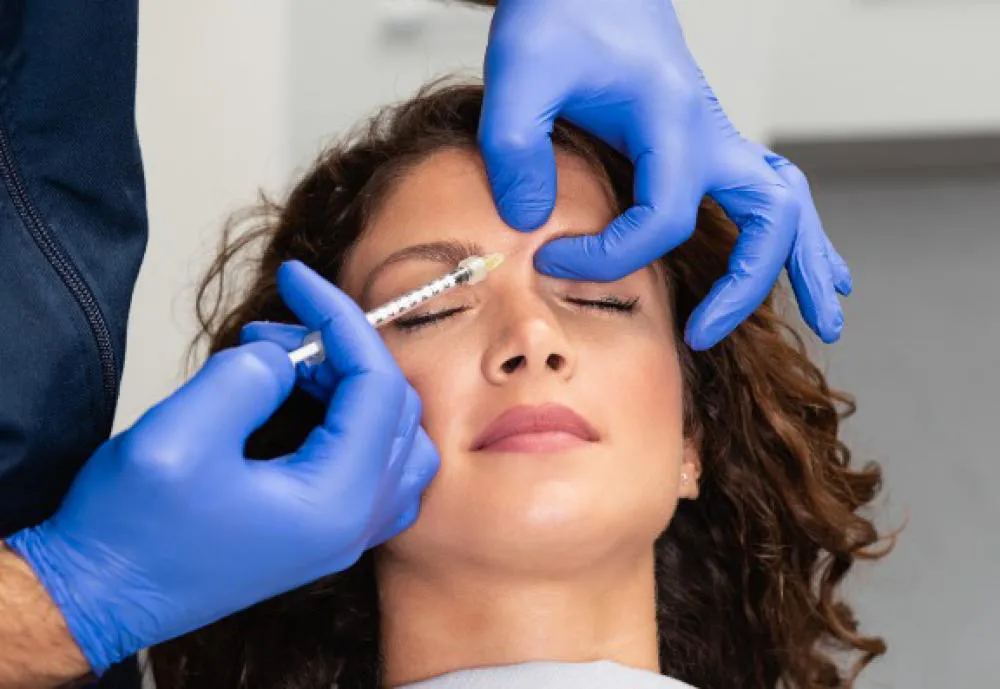As the clock ticks, so does the inevitability of ageing, but not all of us are ready to embrace every line and wrinkle. Enter Botox. Among its popular uses, Botox for forehead lines smoothes out the evidence of frequent furrowing and raising of our brows.
Botox, or Botulinum toxin, has revolutionised the approach to non-surgical cosmetic procedures since its meteoric rise in aesthetic medicine. It's not just about vanishing years off your face; it's about restoring that confidence that comes with a refreshed appearance. This FAQ will walk you through everything you need to know about using Botox to reduce forehead lines.

Quick Summary
- Botox is a non-surgical solution to reduce the appearance of forehead lines.
- Treatment costs around £200-400.
- Suitable for individuals looking for minimally invasive aesthetic improvements.
- It is a quick and relatively painless procedure with no downtime.
- Results can last from three to six months.
- It is important to choose a qualified practitioner for the best outcomes.
For more detailed information, please see below.
What are Forehead Lines and Why Do They Appear?
Forehead lines, those horizontal streaks that span across our brow, are more than just markers of age; they are the storybook of our expressions, etched into our skin through years of smiles, frowns, and surprised lifts of the brow.
Understanding Forehead Lines:
Forehead lines can be broadly categorised into two types:
- Horizontal Lines: These are primarily caused by raising our eyebrows, an action controlled by the frontalis muscle. These lines are often the first telltale signs of ageing.
- Expression Lines: Also known as worry lines, these appear due to repeated frowning, contributing to a sometimes unintended stern or fatigued appearance.
These lines begin as dynamic wrinkles, only appearing with movement. They gradually etch deeper into our skin, becoming static lines visible even when our face is at rest. This transition marks a crucial stage where cosmetic intervention can be most effective.
Factors Contributing to Forehead Lines:
The formation of these lines is influenced by several factors:
- Ageing and Loss of Skin Elasticity: Our skin loses collagen and elastin as we age, making it less able to snap back into place after movement. This natural reduction in skin elasticity leads to more permanent lines.
- Lifestyle Factors: Extended exposure to sunlight contributes significantly to premature skin ageing, as UV rays break down collagen faster. Other factors include smoking, which reduces blood flow to the skin, and chronic stress, which can cause increased tension in the forehead.
- Genetic Predispositions: Some people are more genetically inclined to develop deeper or more pronounced forehead lines, which are influenced by their facial muscles' natural structure and movement.
Understanding these causes is crucial, not just for considering Botox but for a holistic approach to skincare and lifestyle choices that can mitigate the early appearance of these lines. Now that we've covered why these forehead lines appear let's explore how Botox works to smooth them out.
The Science Behind Botox
How Botox Works:
Botox is derived from Botulinum toxin, a neurotoxic protein produced by the bacterium Clostridium botulinum. While it sounds daunting, this toxin's cosmetic form is safe and effective when used in controlled doses. Here’s how it works:
- Neurotransmitter Blocking: When injected into the muscles, Botox blocks the release of acetylcholine, a neurotransmitter responsible for triggering muscle contractions. This reduction in neurotransmitter activity means that the muscle stays relaxed.
- Muscle Relaxation: Botox inhibits muscle contractions that cause the skin above to crease and form wrinkles. The result is a smoother, more youthful appearance on the forehead that lasts until the nerve endings regenerate and muscle activity gradually returns.
Safety and Efficacy:
Botox's journey from a potential therapeutic agent to a staple in cosmetic enhancement is backed by rigorous testing and approval processes:
- FDA Approval: Botox was first approved by the U.S. Food and Drug Administration (FDA) for cosmetic use in 2002, specifically for treating frown lines. Its use has since expanded to include forehead lines and crow’s feet, among other areas.
- Clinical Studies: Numerous studies have demonstrated Botox's efficacy and safety, showing significant improvement in the appearance of forehead lines with minimal side effects for most users.
- Misconceptions Addressed: Despite its popularity, misconceptions about Botox causing a 'frozen' face persist. When administered correctly by a qualified professional, Botox produces natural-looking results, maintaining facial expression while smoothing out lines.
The Botox Treatment Procedure for Forehead Lines
Opting for Botox to smooth out forehead lines is not just about looking good - it's about feeling good. The procedure is relatively quick and straightforward, but knowing what to expect can ease nerves and help you plan the treatment effectively.
Let's break down the Botox treatment steps, from the initial consultation to post-procedure care.
Before the Procedure:
-
Initial Consultation:
- Assessing Suitability: A qualified practitioner will assess your skin condition, discuss your medical history, and understand your aesthetic goals to determine if Botox is right for you.
- Setting Expectations: It is crucial to have a clear conversation about what Botox can and cannot do for you. This discussion ensures that your expectations align with the potential outcomes.
-
Pre-Treatment Advice:
- Skincare Regimen: You might be advised to avoid certain skincare products and medications that could increase bruising, such as aspirin or other blood thinners.
- Lifestyle Adjustments: Recommendations might include avoiding alcohol a few days before the treatment and scheduling the session when you can have a relaxed, stress-free day.
During the Procedure:
-
The Injection Process:
- Cleanse and Mark: The treatment area will be cleansed, and if necessary, your practitioner may mark the specific sites on your forehead where Botox will be injected.
- Injection: Small amounts of Botox are injected into the marked areas of the forehead using a fine needle. The injections are quick and typically describe a slight pinch or discomfort, lasting only a few seconds each.
-
Duration and Sensation:
- Time Efficient: The entire procedure usually takes no more than 10 to 20 minutes.
- Comfort Measures: Although minimal pain, some clinics offer topical anaesthesia or ice packs to numb the area before injections to make the process more comfortable.
After the Procedure:
-
Post-Treatment Care:
- Immediate Aftercare: You'll be advised not to rub or massage the treated area for several hours to prevent the toxin from spreading to unintended muscles.
- Activity Restrictions: It's generally recommended to stay upright for several hours and avoid strenuous activities for the rest of the day.
-
Recovery Timeline and Results:
- Visible Improvements: While some may notice improvements within a few days, the full effects of Botox usually become apparent within one to two weeks after treatment.
- Duration of Effects: The smoothing effects of Botox on forehead lines typically last between three to six months, after which the treatment can be repeated.
Understanding the Botox procedure from start to finish prepares you for what to expect and highlights the importance of following professional advice for the best results.
Benefits of Botox for Forehead Lines
Cosmetic Improvements:
-
Youthful Appearance:
- Smoother Skin: Botox effectively smooths out the wrinkles and lines on the forehead, giving the skin a more youthful and relaxed appearance.
- Subtle Lifting Effect: Botox relaxes the forehead muscles and can also subtly lift the brows, enhancing the overall facial expression.
-
Long-Lasting Results:
- Duration of Effectiveness: The results of a Botox treatment can last between three to six months, depending on individual factors such as skin type and muscle activity.
- Maintenance Treatments: Botox treatments can be regularly scheduled for continuous benefits to maintain the smooth appearance of the forehead.
Psychological Benefits
-
Enhanced Self-Confidence:
- Improved Self-Image: Achieving a fresher, more vibrant look can significantly boost your self-esteem and how you perceive yourself.
- Positive Mental Outlook: Many recipients of Botox report a positive impact on their mood and overall mental health, often attributed to increased confidence in their appearance.
-
Social and Professional Perceptions:
- Perceived as More Approachable: Smoother forehead lines often eliminate unintentional signs of stress or anger, making individuals appear more approachable and friendly.
- Professional Benefits: Maintaining a youthful and energetic look can potentially have professional advantages in careers where appearance is important.
Botox offers a unique blend of cosmetic and psychological benefits beyond deep skin. Smoothing out forehead lines not only enhances physical appearance but also fosters a positive self-image and can improve interpersonal interactions.

Potential Side Effects and Risks
While Botox is celebrated for its ability to smooth forehead lines and rejuvenate the face, like any medical treatment, it comes with potential risks and side effects. Awareness of these can help you make a fully informed decision and prepare for any possibilities following the procedure.
Common Side Effects:
-
Minor and Temporary:
- Redness and Swelling: Immediately after the injection, you might notice slight redness or swelling at the injection sites, which typically subsides within a few hours.
- Bruising: Some individuals might experience bruising, especially if sensitive skin or blood-thinning medications are involved. These are usually small and fade within a week.
-
Discomfort:
- Headaches: A mild, temporary headache is not uncommon post-Botox, especially for first-time users. It resolves within 48 hours.
- Sensation of Tightness: Some patients report a feeling of tightness in the treated area, which generally eases as the Botox takes effect.
Rare Complications:
-
Muscle Weakness:
- Unintended Spread: In rare cases, Botox can spread slightly beyond the intended area, causing temporary weakness or drooping of nearby muscles. This is usually reversible as the toxin's effects wear off.
-
Asymmetry:
- Uneven Results: If Botox is not applied symmetrically, or if individual muscle reactions vary, it can lead to an uneven appearance, which skilled practitioners can usually correct in follow-up sessions.
-
Serious Reactions:
- Allergic Reactions: Very rarely, individuals may have an allergic reaction to Botox, which requires immediate medical attention.
Guidelines on When to Seek Medical Advice:
- Post-Procedure Care: Follow all aftercare instructions your practitioner provides to minimise risks.
- Monitoring Symptoms: While most side effects are mild and temporary, contact your healthcare provider if you experience unusual symptoms, such as difficulty breathing, vision changes, or if the injection site shows signs of infection.
Understanding these potential side effects and risks helps set realistic expectations and prepare for Botox treatment. It's crucial to discuss any concerns with your practitioner beforehand and ensure you are in the hands of a qualified professional to minimise the likelihood of complications.
Choosing the Right Practitioner
When considering Botox for forehead lines, the importance of selecting the right practitioner cannot be overstated. The skill and expertise of the injector play a crucial role in achieving safe, effective, and aesthetically pleasing results.
Here's how you can ensure you are in good hands for your Botox treatment.
Qualifications to Look For:
-
Medical Credentials:
- Certified Professionals: Ensure that the practitioner is certified as a licensed doctor, nurse, or dermatologist to administer Botox. This ensures they have the necessary medical training to understand facial anatomy and manage any complications.
- Specialised Training: Look for practitioners who have undergone specific training in cosmetic Botox injections. Certificates from recognised training courses or workshops are a good indicator of their commitment to their craft.
-
Experience:
- Years of Practice: More experienced practitioners typically provide more consistent and natural-looking results.
- Area of Specialisation: Practitioners who specialise in facial aesthetics, particularly Botox, are more likely to be adept at tailoring the treatment to your specific needs.
Finding a Reputable Clinic:
-
Clinic Reviews and Reputation:
- Patient Testimonials: Look for reviews and testimonials from previous clients. These can provide insights into their experiences and the outcomes they achieved.
- Online Presence: A professional clinic often maintains a robust online presence, showcasing their work, sharing before-and-after photos, and providing detailed information about their services and practitioners.
-
Consultation Process:
- In-depth Consultation: A good practitioner will offer a comprehensive consultation to discuss your aesthetic goals, evaluate your suitability for Botox, and explain the procedure and potential risks in detail.
- No Pressure: Be wary of clinics that try to upsell or pressure you into additional treatments. A reputable practitioner will prioritise your desires and health over making a sale.
Preparing for the Consultation:
- Questions to Ask: Prepare a list of questions to ask during your consultation, such as details about their experience with Botox, the expected outcomes, and how they handle complications.
- Realistic Expectations: During the consultation, ensure that the practitioner sets realistic expectations for the treatment's results. They should be honest about what Botox can and cannot do for your specific case.
Choosing the right practitioner is as crucial as deciding on the treatment itself.
Cost Considerations and Insurance
Navigating the financial aspects of Botox treatments is essential for planning and managing your expectations. Understanding the costs involved and exploring potential insurance or financing options can help you budget effectively for your cosmetic goals. Let’s delve into the cost considerations and the role of insurance in Botox treatments for forehead lines.
Overview of Average Costs:
In general, botulinum toxin forehead treatment costs around £200-400.
-
Variable Pricing:
- Per Unit Pricing: Botox is often priced per unit, with forehead treatments typically requiring between 10 to 30 units depending on the individual's muscle strength and the extent of the lines.
- Geographical Variations: The cost can vary significantly based on the clinic's location and local market conditions. Urban areas with higher costs of living might charge more.
-
Provider Expertise:
- Skill and Reputation: Highly experienced practitioners or those with a strong reputation in cosmetic Botox may charge more for their services. This is often reflective of their expertise and the consistent results they provide.
Insurance and Financing:
-
Cosmetic vs. Medical:
- Typically Not Covered by Insurance: Since Botox for forehead lines is considered a cosmetic procedure, it is generally not covered by health insurance plans.
- Exceptions: If Botox is used for medical reasons, such as treating chronic migraines or certain muscular disorders, some insurance plans might cover part or all of the cost.
-
Financing Options:
- Payment Plans: Some clinics offer financing plans or payment options to help manage the costs over time. This can make the treatment more accessible without requiring full payment upfront.
- Credit Options: Healthcare-specific credit lines, such as those offered by medical credit companies, can be used for cosmetic procedures. These often come with promotional interest-free periods or manageable monthly payments.
Additional Costs:
- Follow-up Treatments: Since the effects of Botox are temporary, consider the long-term cost implications of regular treatments to maintain the desired appearance.
- Complementary Treatments: Sometimes, practitioners might recommend complementary treatments such as fillers or skincare products to enhance the results of Botox. These will be additional costs to consider.
When considering Botox, it's vital to factor in the full scope of potential expenses—not just the initial treatment but also the maintenance and supplementary procedures. Detailed discussions with your chosen clinic can provide a clearer estimate tailored to your specific needs and treatment plan.
Conclusion
It's clear that Botox offers a promising solution for those seeking to diminish the signs of ageing and embrace a more youthful appearance.
Recap of Key Points:
- Effectiveness and Science: Botox temporarily paralyses the muscles, contributing to forehead lines and leading to smoother skin and a refreshed look. Scientific research and FDA approvals support its efficacy.
- Procedure and Safety: The treatment is quick, with minimal discomfort and minimal downtime, making it an attractive option for busy individuals. However, it's crucial to be aware of potential side effects and the importance of choosing a qualified practitioner to ensure safety and the best results.
- Psychological Benefits: Beyond physical improvements, Botox can significantly boost self-esteem and confidence, positively impacting social interactions and overall quality of life.
- Cost Considerations: While not covered by insurance, understanding the cost structure and planning for periodic maintenance can make Botox a viable option for many.
Final Thoughts:
Choosing to undergo Botox is not merely about cosmetic changes but about making an informed health decision that aligns with your personal and aesthetic goals.
If you're considering this treatment, consult a professional to discuss your specific needs and ensure you are a suitable candidate for Botox. Remember, the goal is to look younger and feel revitalised and confident in your skin.
With all this information at your fingertips, you're better equipped to decide if Botox for forehead lines is right for you. Embrace the journey towards a more youthful you with confidence and assurance.
Book Your Botox Consultation Today
As you will have learnt, Botox is a great tool to help you look younger and fresher. It’s important that you get treated by an experienced, medically trained, and qualified practitioner who will inject you safely.
As always, if you have any questions you can use our Botox Q&A where you can ask for more advice direct from a trusted, experienced medical practitioner.

Author: Anna Kremerov
Mrs Anna Kremerov is an award-winning Nurse Practitioner known for Aesthetic Medicine and non-surgical procedures. She is the Founder of Anna Medical Aesthetics, the only CQC registered aesthetic medical practice in Swindon and a MaiLi Centre of Excellence for the South West of England.
Anna and her team have built up an impeccable reputation with over a hundred 5-star patient reviews on Google and Trustpilot.
Anna has over 22 years of combined medical experience in Intensive Care, Woman Health, Primary Care and Aesthetics Medicine.


